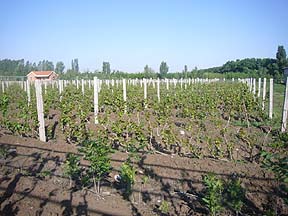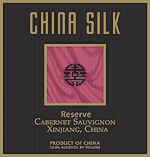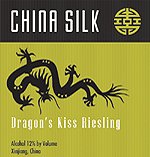By Jim Boyce
One quirk of China’s wine makers is that some of their brands are easier to find abroad than at home. I email interviewed Steve Clarke of China Silk, an export-only wine outfit based in Xinjiang, in the country’s far northwest, and asked him about the company’s wines, export strategy, and marketing strategies.
China Silk’s Steve Clarke
How did you get involved in the winery, where is it located, and what is its scope?
I developed the China Silk brand from living in China and not knowing anything about wine – except how to drink it.
I purchased wines that caught my attention in Carrefour, such as Cabernet Sauvignon made in China, and I got curious. These wines were not good, but they got me thinking – what is the history of wine making in China and what kind of business do Chinese wine producers have internationally? I found that China is arguably the oldest wine-making nation, possibly dating back 9000 years.
It is also a large producer of wine. At that time, in 2005, China was the seventh largest wine producer. Now, it is fifth.
Yet, of the USD26 billion of wine sold in the United States each of the last three years, China was only shipping about USD125000. This lack of market share led to my interest and investment in China’s wine sector.
I visited wineries around China and found my winery in Xinjiang, on the same latitude as Napa and the Loire Valley, and along the fabled Silk Road, which was the genesis of the China Silk brand.
The wines made for China Silk come from the largest vineyard in Asia [Suntime]. I brought in a Kendall Jackson wine maker to make them based on the competitive palate of the Western consumer.
What kind of wines are you making and why did you pick those particular grapes?
We have five wines: Marco Polo white (90 percent Chardonnay, 10 percent Riesling); Marco Polo red (90 percent Cabernet Sauvignon, 5 percent Merlot, 5 percent Syrah); Dragon’s Kiss Riesling; Emperor’s Delight rose (100 percent Syrah), and Reserve Cabernet Sauvignon, which is aged in French vanilla oak barrel barrels for at least one year.
The wines chosen are based on current sales in the U.S. and the grapes in which we are strongest.
The vineyard has been disease-free and is located in a mature agricultural mountainous region.
What kind of logistical issues are there with making wine in Xinjiang?
Logistics is not really an issue as we ship our wines from Urumqi to Shanghai via train in dedicated containers, then by ocean to the U.S. west coast.
China Silk wines are only sold in the U.S.? Why aren’t you targeting the local market?
China Silk wines are focused on the large mature U.S. market. When we accomplish our national roll out – we are in 14 states and intend to be in the others by the end of 2009 – we will address other international opportunities.
What attitude toward Chinese wines do you find in the U.S. and what is your marketing approach there?
U.S. consumers have a strong interest in China, and in the long history of winemaking and the China Silk brand story.
We are getting national attention as the New York Times recently wrote an article about us. Newsweek is doing an article on China Silk and I am being interviewed by CNBC news this month. In addition, Men’s Journal notified me yesterday that their May issue has an article about China Silk wines.
Conde Nast travel magazine is planning to visit my winery with me in May or June, for an article slated to appear in the third quarter.
In 2009, we will be advertising weekly on Yan Can Cook, Martin Yan’s TV show, which is shown in 49 countries and in all U.S. states.
We are doing tasting events around the country along with local on- and off-premise events. We have also penetrated PF Chang’s – America’s premier national contemporary chain of Chinese restaurants – and recently been added to a national grocery store chain, QFC (Kroger), in over 200 locations in three states. This is a 2400-store chain, and goes a long way in our national rollout plans.

Growing grapes, Xinjiang-style (China Silk)
Grape Wall has no sponsors of advertisers: if you find the content and projects like World Marselan Day worthwhile, please help cover the costs via PayPal, WeChat or Alipay.
Sign up for the free Grape Wall newsletter here. Follow Grape Wall on LinkedIn, Instagram, Facebook and Twitter. And contact Grape Wall via grapewallofchina (at) gmail.com.



I am curious why the design of the label doesn’t encompass more the true culture of the surrounding areas.